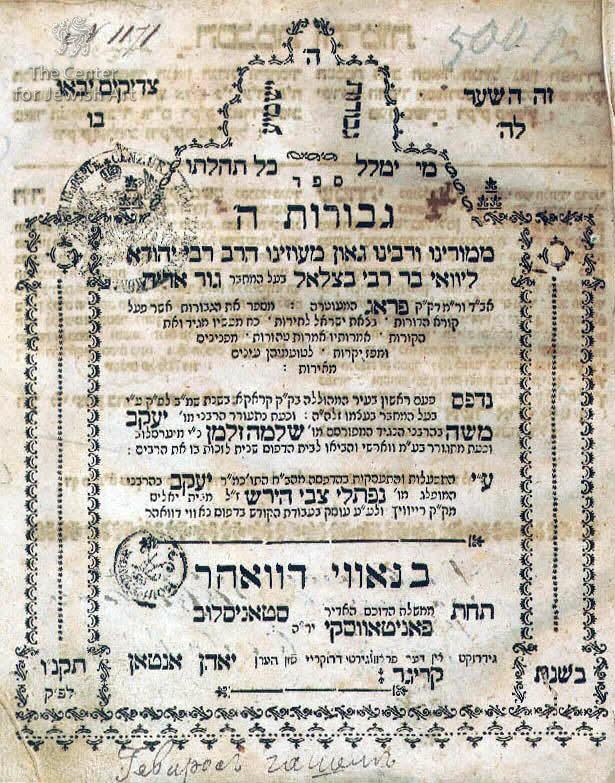Obj. ID: 36823
Jewish printed books Gevurot ha-Shem by Maharal Yehudah Loew ben Bezalel, Nowy Dwór Mazowiecki, 1796

This text was prepared by William Gross: This is a classic work on the holiday of Passover by the Maharal. Judah Loew ben Bezalel, alt. Lצw, Loewe, Lצwe, or Levai, (between 1512 and 1526? – 17 September 1609) widely known to scholars of Judaism as the Maharal of Prague, or simply The MaHaRaL, the Hebrew acronym of "Moreinu Ha-Rav Loew," ("Our Teacher, Rabbi Loew") was an important Talmudic scholar, Jewish mystic, and philosopher who, for most of his life, served as a leading rabbi in the cities of Mikulov in Moravia and Prague in Bohemia.
Within the world of Torah and Talmudic scholarship, he is known for his works on Jewish philosophy and Jewish mysticism and his work Gur Aryeh al HaTorah, a supercommentary on Rashi's Torah commentary. The Maharal is the subject of a nineteenth-century legend that he created The Golem of Prague, an animate being fashioned from clay.
Rabbi Loew is buried at the Old Jewish Cemetery, Prague in Josefov, where his grave and intact tombstone can still be visited. His descendants' surnames include Loewy, Loeb, Lowy, Oppenheimer, Pfaelzer, Lowenstein and Keim.
The Maharal was probably born in Poznań, Poland—though Perels lists the birth town mistakenlyas Worms in the Holy Roman Empire—to Rabbi Bezalel (Loew), whose family originated from the Rhenish town of Worms. His birth year is uncertain, with different sources lis ting 1512, 1520 and 1526. His uncle Jakob ben Chajim was Reichsrabbiner ("Rabbi of the Empire") of the Holy Roman Empire, his brother Chaim of Friedberg a famous rabbinical scholar. There is no documented evidence of his having received formal religious education, leading scholars to conclude that he was an extremely gifted autodidact.
His family consisted of his wife, Pearl, six daughters, and a son, Bezalel, who became a Rabbi in Kolín, but died early in 1600. He was independently wealthy, probably as a result of his father's successful business enterprises. He accepted a rabbinical position in 1553 as Landesrabbiner of Moravia at Mikulov (Nikolsburg), directing community affairs but also determining which tractate of the Talmud was to be studied in the communities in that province. He also revised the community statutes on the election and taxation process. Although he retired from Moravia in 1588 at age 60, the communities still considered him an authority long after that.
One of his activities in Moravia was the rallying against slanderous slurs on legitimacy (Nadler) that were spread in the community against certain families and could ruin the finding of a marriage partner for the children of those families. This phenomenon even affected his own family. He used one of the two yearly grand sermons (between Rosh Hashanah and Yom Kippur 1583) to denounce the phenomenon.
He moved back to Prague in 1588, where he again accepted a rabbinical position, replacing the retired Isaac Hayoth. He immediately reiterated his views on Nadler. On 23 February 1592, he had an audience with Emperor Rudolf II, which he attended together with his brother Sinai and his son-in-law Isaac Cohen; Prince Bertier was present with the emperor. The conversation seems to have been related to Kabbalah (Jewish mysticism, Hebrew: קַבָּלָה) a subject which held much fascination for the emperor.
In 1592, the Maharal moved to Poznań, where he had been elected as Chief Rabbi of Poland. In Poznań he composed Netivoth Olam and part of Derech Chaim (see below).
According to Jewish tradition, the Maharal's family descended patrilineally from the Babylonian Exilarchs (during the era of the geonim) and therefore also from the Davidic dynasty.
The book's Christian printer, Johann Anton Krüger, ran a Hebrew printing press in Nowy Dwór, Neuhof (near Warsaw), from 1781 until 1814. While his printer's mark frequently appears on his publications (see B.689, B.1773 and B.1778) in this volume it is absent.


